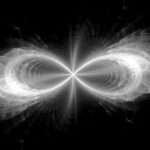I’ve tried to explain the key idea in my essay “The How and the Why of Emergence and Intention” (available for download on Essays) briefly to several friends. My off-the-cuff attempts have tended to “wander towards the goal,” confusing rather than enlightening. Coincidentally, “Wandering Towards the Goal – How do Mindless Mathematical Laws Give Rise to Aims and Intention” is the topic for the Essay Contest, sponsored by FQXi (The Foundational Questions Institute). So here is a quick summary of the key points in the essay.
First – Why I Wrote This Essay
I had two goals in writing the essay. The first goal was to have the FQXi community read the essay and not dismiss it out of hand. The challenge is that FQXi is an elite group of some 300 physicists and cosmologists from around the world (names like Max Tegmark, Anthony Aguirre, Nick Bostrom, David Chalmers, Alan Guth, Martin Rees, Lee Smolin, and Frank Wilczek, among others). I am an “amateur” and do not have the qualifications to be in the Institute. Moreover, the collection of members and competing essayists is heavily tilted to a secular, even anti-religious, point of view. My conclusion is something that many would consider theological and therefore wildly out-of-bounds. So I had to avoid using words that would give the appearance of religiosity and build my argument without offending the sensibilities of the scientific reader.
My second goal was broader – to open secular thinking to the possibility of spiritual concepts. I believe that modern science points to some of the same spiritual truths as the ancient wisdom traditions. But you have to be open to this idea in order to consider the possibilities. I am trying to use science and mathematics to lead to conclusions that extend beyond the empirical boundaries of secular thought — to spiritual truth.
Surprisingly, my essay is doing well! The community ranking process, where this year’s 229 essayists read, comment and score the other essays, is complete, and my essay ranks 5th. The top 30 essays have now been sent to an outside panel for final award selections, to be announced later this summer. There are a variety of award levels, so I am hopeful my essay will be in the final mix.
The Main Argument
Basic physics suggests that everything is running down. A clock stops when the spring winds down (or the battery is drained). Once the milk is spilled on the floor, it will not go back in the bottle. The universe itself is slowly cooling down over billions of years. This idea is linked to a measure called entropy, and the Second Law of Thermodynamics says that entropy always increases.
But complex systems do something else. In the turbulent flows of energy and matter, sophisticated forms and structures seem to emerge spontaneously. Water going down the drain starts to spiral. So do galaxies, and sunflowers. This spontaneous “something else” is called emergence. Sophisticated forms and structures emerge in complex systems. This counter-entropic result works by exporting the “running down” tendency, the entropy, from the local environment to the rest of the environment. So, scientists can now explain how more sophisticated and complex structures emerge in a universe that is, overall, still running down. But they still cannot explain why.
That’s where my essay comes in. I maintain that emergence is a consequence of what I refer to as an intentionality flowing through the universe. I use the word “intentionality” to describe the fact that every object and every system has a direction, movement or purpose — an intention. Even a rolling billiard ball has “intentionality” – and it will strike another billiard ball with a specific force and direction. Every particle, every wave, every atom, every object and every collection of objects (systems) has direction, movement or purpose — it is going somewhere. Hence – intentionality. So, from the beginning of time, everything in the universe is caught up in a process that is moving forward; this is cosmic intentionality at work. This intentionality has a number of interesting qualities:
Attraction: The mathematicians that study complex systems found out that as the new features of a dynamic system emerge, they tend to settle in on particular configurations. Spiral configurations are common! The mathematicians refer to these particular, more common, solutions as “attractor states.” A dynamic system is “attracted to” particular solutions. The behavior of a dynamic system is not random!
Cooperation: A dynamic system evolves as the individual components interact in turbulent conditions, and structure emerges as these components begin to cooperate. Water molecules jostle with each other as gravity pulls them towards the drain, but then begin to cooperate and spin around each other — a spiraling whirlpool develops. Spiral galaxies are stars dancing with each other – each responds to the pull of gravity from the others. Ants cooperate to build and maintain their colony. Chemistry is actually the science of how molecules cooperate by binding together in different configurations, and particular configurations form complex chains of reaction that lead to life itself.
Reciprocity: The cooperation of the components of a system is a form of reciprocity, but, in addition, the components are in a reciprocal relationship with the system. Water molecules shape the whirlpool – and the whirlpool directs their movement. Ants build a colony – the emergent features of the colony protect, preserve and fulfill the destiny of the ants. Ultimately, this reciprocity cascades through the all the levels of physics, chemistry, biology and human behavior. Causal influence goes both ways.

The Conclusion
We all have a word we use when we refer to relationships that reflect intentionality and feature the qualities of attraction, cooperation and reciprocity. That word is love. So I call the cosmic intentionality that flows through the universe – forms of love. This love guides the emergent cascade. This cascade is not random, but in fact leads to increasingly complex, sophisticated and intelligent structures and systems. We observe this process at work in our universe. We can see that it has, through time, and perhaps inevitably, led to self-reflective sentient consciousness. Such consciousness provides the capacity for us to engage with and reflect on the universe, closing the cosmic circle. The universe gives us life, beauty, joy and consciousness – it has loved us. In return, it is possible for us to observe and explore this universe, and to reciprocate that love.
I hope you have enjoyed this quick review! Any thoughts or comments would be welcome… For a download of this essay, please visit the publications page.
















[…] FQXi contest, including three of my prior FQXi essays: The Hole at the Center Of Creation; The How and The Why of Emergence and Intention; and Faith is Fundamental. My key point has been that the fundamental limits that physicists and […]
[…] as I have laid out in my 2017 FQXi Essay The How and The Why of Emergence and Intention, I believe that the frontiers of science are pointing towards a unified spiritual […]